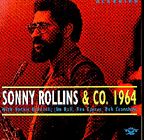
New album chronicles jazz tenor man Sonny Rollins' mid-'60s form
Sonny Rollins & Co. 1964
BlueBird Records
Reviewed by Nicky Baxter
Along with John Coltrane, tenor saxophonist Sonny Rollins was the big gun to arrive on the jazz scene in the 1950s. Indeed, before Coltrane hit, Rollins was considered heir apparent to the tenor throne previously occupied by the likes of Lester Young and Coleman Hawkins.
More than any contemporary, Rollins revived the notion of thematic improvisation: the construction of melody based on a melodic theme or improvised motif. His playing is the very model of what an instrumentalist ought to sound like. Phrasing, articulation, rhythm and timbre combined with a wry wit, have guaranteed the New York�born blower's place in improvisational-music's hall of fame.
Yet Rollins has always been a quirky and mercurial personality. During the Eisenhower years, particularly, his abrupt disappearances from the public eye were the subject of incessant conjecture. But what kept people talking was the Rollins/Coltrane "rivalry"--who was better, the more established Sonny or the upstart from Philly?
Conjecture aside, there appears to be little doubt that in 1959, when Rollins took another sabbatical, the move was in part a response to what Coltrane was doing. When he reappeared two years later with The Bridge, some insiders were surprised that Rollins still sounded like himself. Only better. It wouldn't be the last time the saxophonist would confound critics.
By the time 1964 rolled around, Rollins was working with an assortment of young musicians, pianist Herbie Hancock, guitarist Jim Hall and bassist Ron Carter among them. These players are all featured on the new Bluebird/RCA re-release Sonny Rollins & Co. 1964. The album is comprised of material originally issued under the title The Standard Sonny Rollins; also included is a cut from Now's the Time and a handful of previously unavailable tracks.
The high point is the 15 minute-plus alternate take of Charlie Parker's "Now's the Time." Rather than racing through chord changes, Rollins and company (Hancock, Carter, and Roy McCurdy on drums) investigate the tune's inner workings. Rollins dissects each line, seemingly in search of some hidden meaning. Reinventing "Now's the Time" as a mid-tempo blues, the saxophonist cannot resist tossing a little R&B honky tonk in for good measure. When, just before the song's conclusion, he gets his horn to imitate a muted trumpet, you can almost imagine Rollins winking gleefully at his sleight of hand.
On "Four" and "Blues 'N' Boogie," Hancock drops out, and Bob Crenshaw replaces Carter. Written by Rollins' former employer Miles Davis, "Four" is aggressively up tempo. Goaded by a racing bass line and propulsive drumming, Rollins tears into his solo like a genuine bebop disciple. His exchanges with McCurdy are particularly volatile; the two musicians play cops and robbers on successive choruses like the chase is no game.
At first glance, mating guitarist Jim Hall's gauzy lyricism with Rollins' robust tenor horn would seem like an odd coupling, but in fact, it is a winning match-up. Hall's polished, understated style encourages Rollins' more sensitive musings. "My Ship" illustrates that Rollins can be a consummate team player, as he weaves his way in and around the guitarist's subtle swing. For his part, Hall supplies a sumptuous cushion for his partner's balladic tenor.
Save for his awkward squawking on the session's lead-off track and the poorly recorded "Four" (with Rollins sounding as if he'd been shoe-horned into a bathroom with a malfunctioning mic), Sonny Rollins & Co. 1964 represents some fine, if not superior, performances. It also provides a clue as to what the restless Rollins would be up to in the coming years. Which is to say a helluva lot.
[ Metro | Metroactive Central ]
